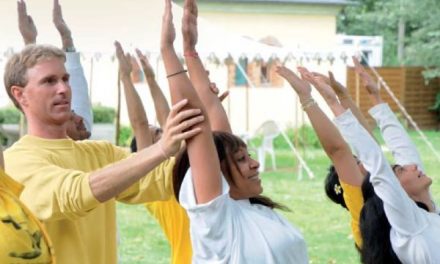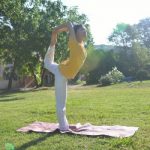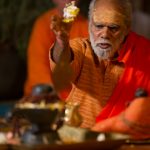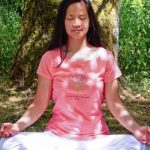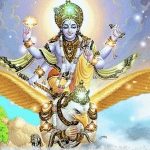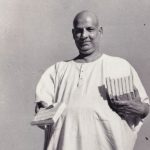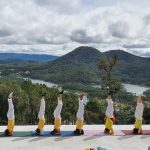
Deepening the Yoga Practice
By Swami Sivadasananda
This article offers practical advice to help you with the inner experience of yoga. It is important to remember that progress in our practice should be approached in a holistic manner.
If we experience difficulties in one aspect of our practice, we can balance these out by other aspects where we may be more proficient. In fact to be strong in one aspect does not necessarily indicate overall progress.
 Asanas and the Three Gunas
Asanas and the Three Gunas
In order to increase harmony and peace within our lives, we need to be aware of the influence of the three gunas or the three qualities of nature. These are sattwa, rajas and tamas.
Connect with Sattwa
Sattwa is the foundation of creativity and inner peace. Watch the sunrise or sunset out in nature. At this time sattwa predominates in the atmosphere and uplifts body and mind. Eat fresh and pure vegetarian food at times when the sun is high, rather than after sunset. Water neutralises energies. Take a shower before practising yoga, but wait at least fifteen minutes after a yoga session before showering. The scent of sandal or rose from good incense or essential oil enhances sattwa.
Avoid Rajas
Avoid all stimulants such as coffee, tea, alcohol, tobacco, drugs, garlic or any of the onion family, as well as synthetic alcohol- based perfumes. Loud music, too much talking, or associating with large groups of people all increase rajasic energy.
Avoid Tamas
Meat and stale food, poorly-ventilated rooms, oversleeping, overeating, lack of cleanliness in your living space, and lack of physical exercise all increase tamasic energy.
Positive Effects of Asanas on the Gunas
The energy changes experienced during asana practice are actually not an increase in quantity, as commonly perceived, but rather a change in quality. The vibratory level changes from tamas and rajas to sattwa.
Imagine a yoga class where half the students enter with a rajasic energy. They are unable to relax, their breath is accelerated and they constantly adjust their pose. The other half of the class is in a tamasic state. Their bodies feel heavy, breathing is short and shallow, and the relaxation pose seems the only attractive posture for them.
Now imagine the class is told to come into the shoulderstand and hold it quietly for three minutes. Those students with rajas, will find the holding uncomfortable. Their minds say: “I need variation.” As they hold the pose, after a minute or so their breath will automatically deepen and slow down, muscles will relax, and the energy will shift to sattwa.
Those students with more tamas in their system will also find maintaining the posture uncomfortable. But their question will be “When can I return to the relaxation pose?” Holding the pose will stimulate the breath and heart beat, and tamas will be transformed into rajas and then into sattwa.
The more we avoid tamasic and rajasic influences in our daily lives and the more contact we have with sattwic influences, the more quickly the asanas will change our vibratory level. With practice, even twenty to thirty minutes of asana practice will be enough to produce a change in the gunas. The practice of asanas gives us tremendous confidence to face whatever challenges life presents us with, because we begin to understand that creativity and peace are accessible with each session. More advanced yogis can change the gunas by mere will power.
Asanas and the Yamas and Niyamas
Both the physical body and the mind are a manifestation of Mother Nature, or shakti, in her microcosmic form. The yamas and niyamas of the eight-limbed or ashtanga yoga system are guidelines for a harmonious relationship with the world, or shakti in her form as macrocosm.
They are non-violence, truthfulness, sublimation of sexual energy, non-stealing, non-acquisitiveness, cleanliness/purity, contentment, austerity, study of the scriptures and surrender to God.
The spiritual aim of asanas and pranayama is to awaken the dormant shakti in the muladhara chakra or root chakra at the base of the spine and to unite her with Siva or the unchanging consciousness in the crown chakra at the top of the head. The higher the shakti moves up in the chakras, the more she is experienced as universal energy. Finally the experience of the inner and the outer shakti become One.
If the universal laws of the yamas and niyamas are ignored, shakti as the Soul of the world is negated. The practice of asanas loses its spiritual meaning and the inner shakti will not reveal herself. Here, the practitioner will tend to shift his attention outwards.
The asana experience will be more isolating than unifying and the shakti will manifest as maya (illusion) in thoughts such as: “Oh what exceptional capacities I have, what exceptional physical purity I have (this thought itself is a mental impurity), what exceptional physical beauty I have.” Asanas practised as “performance yoga” in order to attract the attention of others leads nowhere.
An ashram or yoga retreat is an ideal place to experience the interrelationship of the yamas and niyamas and the asanas. Communal living in simple conditions enriches us when we approach it with a spirit of sharing. If we come with the attitude “what’s in it for me?” we become isolated and end up unhappy and dissatisfied.
The possibilities for tension and friction are innumerable. When they are overcome through yamas and niyamas, the inner shakti responds positively in the asanas and expansion of consciousness occurs while practising.
Karma yoga or the practice of selfless service for the good of others offers the best practical training for the acquisition of the yamas and niyamas.
Pratyahara and Dharana in Asanas
Pratyahara is the imitation of the mind by the senses, which comes by withdrawing the senses from their objects. Raja Yoga Sutras II/54
The five senses function through the projection of prana. It is an illusion to think that we take prana in when we use our senses. For example, for the ear to hear, nerve impulses travel back and forth between the central nervous system and the ear, and prana is projected towards the sensory object.
Through pratyahara or withdrawal of the senses, the senses become so well controlled that they simply follow the mind. If the mind does not want to hear sounds, the sense of hearing is automatically withdrawn. Asanas can help attain mastery over this limb of raja yoga.
When we hold an asana we focus on the movement of prana in the body. We project prana to contract certain muscles and then withdraw it again to relax them. The movement of sense-energy is similar, only the vibratory level is higher.
During asana practice, we may feel subtle sensations in the body, such as body weight, a subtle warmth or the perception of infinity when we visualise the space in the atoms of the cells. These experiences turn the senses inward, thus avoiding, in a natural manner, the need to repress the outward-moving tendency. The sensory experience in asanas is so attractive, that these outward-moving tendencies are relinquished with little or no resistance.
The mind is prana at the highest vibratory level. Dharana or concentration is difficult because we must abandon all thoughts that distract us from the object of concentration. In asanas there are innumerable ways to help the mind concentrate.
There is variety, and yet this variety is contained within one field, the body. We develop dharana by projecting mental prana onto that one field. The more we practise control of prana through asanas, the better the chance we have of experiencing dharana.
Overcoming Body Conditioning
The way our body is built actually determines how we view time and space. We look ahead into the future, while behind us lies the past. When we are awake with our eyes open, we create mental patterns which lead us to perceive life in terms of future or past events. With this to contend with, how can we dream of reaching the yogic ideal of “being here now”?
 Yoga asanas skillfully take us away from the notions of ahead and behind, front and back. Forward bends are counterbalanced by backward bends, and vice versa. Even though there may be quite some movement during a yoga class, we do not stray from the mat.
Yoga asanas skillfully take us away from the notions of ahead and behind, front and back. Forward bends are counterbalanced by backward bends, and vice versa. Even though there may be quite some movement during a yoga class, we do not stray from the mat.
During relaxation, we move systematically from the feet to the head, following the pathways of the peripheral nervous system and back to the central nervous system, i.e. the spinal cord and the brain. The same pattern is applied in pranayama and the meditation exercises. The upward flow of energy not only takes us away from spatial perception, but stimulates the chakras, creating a different perception of time.
Overcoming the Conditioning of Language
The same limitations, which have their source in the environment, occur with language.
Here is an object – a table for example, and it must have a name to have a form. But also very subjective experiences such as emotions are labeled with words.
These words reflect a collective consciousness, which does not necessarily correspond to the consciousness of the individual. The average vibratory level in society is of rajas (activity, passion). Language is not only used in spoken communication, but is also the fundamental vehicle for the thinking process. It is therefore difficult
to raise the awareness to higher levels of consciousness, if the very words with which we think correspond to the relatively low vibration of the collective consciousness.
Mantras are words which were not created to describe objects and are not related to the collective consciousness. They were revealed to sages in deep meditation. The root sounds of mantras correspond to the vibratory levels of the chakras.
Symbolically traditional drawings of the chakras represent petals of the chakra- lotus, each associated with one letter of the Sanskrit alphabet. When we repeat a mantra, we bypass the mechanism of ordinary language, and connect to higher mental states such as intuition and inner peace.
Swami Sivadasananda is Yoga Acharya and teaches workshops throughout the Sivananda Centres in Europe and Teachers’ Training Courses Worldwide.

